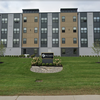GCSD drafts $110M budget for next year: spending up nearly 5%, taxes up nearly 3%
GUILDERLAND — The school board here is largely supportive of the draft $110,191,650 million budget for next year presented by Superintendent Maries Wiles.
The tax levy is slated to go up 2.98 percent, staying under the state-set cap of 3.20 percent. The budget itself is up 4.98 percent over this year.
The board is set to adopt the budget on April 12 and the public votes on May 17.
Wiles, in answering questions from the board and the public about her draft budget on March 15, said that the nearly 5-percent spending increase and the nearly 3-percent tax increase “are the highest they've been in my time here” as she stressed the importance of “balance” in not overburdening taxpayers.
Despite the second of three years in the unprecedented restoration of state Foundation Aid along with federal funds to ease the burdens of the pandemic, the district was unable to draft a budget that fulfilled its wish list — most notably reducing class sizes in all three middle-school grades.
State aid for Guilderland is up nearly 11 percent over this year and is expected to total close to $30 million next year. The federal aid for pandemic relief is not part of the district’s operating budget and is to be spent on one-time uses.
In making her budget presentation on March 8, Wiles said she had shortened the district’s mission to this: “Making sure all students, and by that we mean each and every one … are future ready, ready for whatever comes ahead.” She noted the future is uncertain.
Wiles also stressed the need of being respectful to taxpayers. “This has been a rough go,” said Wiles.
The budget proposal for next year maintains or lowers class sizes, preserves all programs and services, maintains staff, preserves social and emotional support, and includes a new technology leadership post.
The district currently employs 713 full-time workers and 218 part-time workers. Another way to look at the district’s 931 employees is that 501 are teachers; 402 are support staff — which includes teaching assistants, teacher aids and monitors, custodians, bus drivers and bus aids and mechanics,maintenance workers, food-service workers, office staff, technicians and non-instructional supervisors; and 28 are administrators or supervisors.
Enrollment next year is expected to decline at the high school (by 48 students) while increasing at the five elementary schools (by a total of 23 students) and at the middle school (by 49 students) — an overall increase of 24, up from 4,832.
“We see this enrollment growth to be a long-term trend,” said Wiles.
The superintendent’s draft is based on the governor’s executive budget; the one-house budget discussed by the state Assembly and Senate looks to be following that closely when it comes to school aid. The deadline for a final state budget is April 1.
When Guilderland discussed a roll-over budget in December, school leaders at the time projected a budget for next year of just over $109 million.
Several costs are making next year’s projections at Guilderland markedly higher than this year:
— Transportation, both because of increasing fuel costs (up an anticipated $71,250) and a driver shortage that has led the district to contract out routes (an anticipated increase of $563,245);
— New special-education students moving into the district. Private special-education costs are expected to go up $1,129,440. “We have no choice but to serve our students,” said Wiles;
— Debt payments are up $469,943;
— Network security costs following a breach last year are up $155,105. “Honestly, I think this is a terrific investment,” said Wiles. “The world of cyber security is even more perilous than it was a year ago”; and
— The decision to reduce class size for eighth-graders at a cost of $220,400.
Although Guilderland’s fund balance is lower than its Suburban Council counterparts, the draft budget calls for taking $270,000 from the fund balance.
The lion’s share of costs, as with all school budgets, is to pay for staff; 78.4 percent of the proposal is for salaries and benefits.
“It takes a large number of people to provide an education program,” said Assistant Superintendent for Business Neil Sanders.
Salaries for teachers are up roughly $1.1 million and for staff, roughly half-a-million dollars while benefits are up about $890,000. These are all set by contract. Additionally, costs for Board of Cooperative Educational Services are up roughly $1.5 million.
Responses
On March 15, the nine school board members and the public had a chance to question and discuss the budget draft.
Several parents were concerned that Altamont Elementary School, the smallest of the district’s five elementary schools, has just a part-time librarian while the other schools each have a full-time librarian.
Altamont’s principal, Peter Brabant, said he had advocated for having eight-tenths, rather than the current six-tenths, of a librarian post, which would have made the librarian-to-student ratio the same as the other schools.
Wiles termed that “a worthwhile and appropriate request” but said, “This really came down to … having so little room … based on other expenses.” She said there were “many, many requests for additional staffing.”
Board Vice President Gloria Towle-Hilt said she was concerned about equity with Altamont students being underserved at a time when relevancy is “more and more crucial.” Blanca Gonzalez-Parker agreed, saying, “I feel like there’s a disparity.”
Board President Seema Rivera asked about using federal funds to pay the $13,600 that the extra two-tenths of a librarian’s post in Altamont would cost. Wiles responded that the federal funds would be “going away” so shouldn’t be used for permanent posts. She also said, with COVID-19 restrictions lifting, “We more than welcome volunteers.”
“Most importantly, we are every day still uncovering more information about our students’ needs and so we don’t simply want to spend the federal money all at once …,” said Wiles on March 8. “We want to have some resources available in case we identify some new needs.”
She added, “We’re still in the pandemic … We just need to be ready if new issues come up.”
Board member Judy Slack asked on March 15 about using one of the extra teaching posts that have been budgeted to fill out the Altamont librarian post to which Brabant responded there are now seven or eight “bubbles” — classes that could go over the recommended number of students — at the elementary level.
“Some bubbles pop and some overflow,” said Wiles, stressing the importance of holding on to the unassigned posts until more exact enrollment figures are determined.
The district guidelines are to have classes of 18 to 23 students in kindergarten, first, and second grade; 24 to 26 students in third, fourth, and fifth grades; a limit of 26 students in middle school classes; and a limit of 30 students in high school classes.
Rivera expressed concerns about school start and dismissal times not yet being squared away. Guilderland, after years of discussion, had moved to a later start time at the high school because of research showing adolescents need more sleep.
“Our goal is to have it pinned down by May 1 ..,” said Wiles. “We haven’t had a single day this year where all of our buses arrived on time. Not one.”
The district, like many others, hasn’t been able to find bus drivers. “We’re really in a box,” said Wiles, noting the spread-out nature of Guilderland’s schools and the heavy traffic particularly on Route 20 as well as the shortage of drivers.
“We need 45 minutes between runs and the day is only so long,” said Wiles.
Board member Rebecca Butterfield voiced concern about the sustainability of drawing down the fund balance. “Are w\we whittling away too much of our savings?” she asked.
“The only way to keep … our tax rate within reason was to apply some more revenue,” Sanders responded.
Kim Blasiak, who was appointed to the board in October, described herself as a special-education advocate and said counselors and social workers at the school are “inundated.” Describing the ratio of guidance counselors to students as 1 to 260, she said, “That’s insane.”
Blasiak went on, “It’s scaring me because it’s not scaring anyone else.”
“We have used some of our federal funds to add social-emotional services that we are planning on carrying forward next year,” Wiles responded.
Gonzalez-Parker, too, said she’d like to add a social worker as well as a school resource officer, and that she was disappointed all of the middle-school class sizes couldn’t be reduced.
“Here goes my next election,” said Gonzalez-Parker, asking, “Just how bad is it to go over the tax levy [limit] to address some of these things? … Has it ever been done before and what’s the worst-case scenario?”
While it hasn’t been done at Guilderland, Sanders said, “It has been done before. It has also failed before.”
A school budget over the state-set levy limit requires 60 percent of the voters to approve it; if the budget is voted down, the district can put up the same budget or a revised budget. If that fails, by state law, there can be no tax increase over the prior year.
“I’m clutching the chair,” said Wiles, explaining that would mean $2.2 million worth of reductions.
Wiles went on, “I actually think we do an extraordinary job of meeting student needs.”
She tallied the number of school counselors, social workers, and psychologists at Guilderland compared to other Suburban Council districts. The average is one to 176 students while Guilderland’s ratio is one to 165 students.
At Guilderland, the total number of adults employed to every one child is 10.1. “I think that’s extraordinary,” said Wiles.
“I don’t care where we fall in the Suburban Council,” said Blasiak. “We’re Guilderland and these are our students … Our adults are sinking too.”
“Besides thinking of our needs, we need to think of our community,” said Towle-Hilt. “It’s not been easy for anyone,” she said of dealing with the pandemic.
Towle-Hilt advised doing “whatever we can do to find that delicate balance of respecting the community, what it can afford, and what we might need and our students need.”
Sanders noted that, after Guilderland receives the promised third year of replenished Foundation Aid, “We’re back to normal … not the gigantic amount we’ve seen to catch everybody up.”
Slack echoed Towle-Hilt’s thoughts, noting many taxpayers in the district don’t have children in school and they are thinking, “I don’t have more to give you.”



